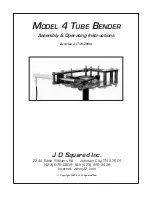Reviews:
No comments
Related manuals for JOURNEY II BCS

1
Brand: Fender Pages: 15

4
Brand: J D Squared Pages: 18

8009
Brand: Keithley Pages: 36

1200
Brand: Rain-Flo Irrigation Pages: 16

Matrix 400
Brand: Datalogic Pages: 20

Matrix 320
Brand: Datalogic Pages: 188

9010
Brand: KaVo Pages: 49

EX-100
Brand: Easson Pages: 33

MET ONE 3400 Series
Brand: Hach Pages: 48

LanTEK IV
Brand: IDEAL Networks Pages: 60

IceSense3
Brand: IceCure Pages: 104

PFMR 1600 A1
Brand: Parkside Pages: 95

PWS
Brand: GE Pages: 18

LUXOMAT net PBM-KNX-DX-4W
Brand: B.E.G. Pages: 16

PRO IS2
Brand: Unika Pages: 8

YV-30
Brand: BH FITNESS Pages: 24

BFMC10
Brand: Best Fitness Pages: 26

Rip Trainer
Brand: TRX Pages: 2

















